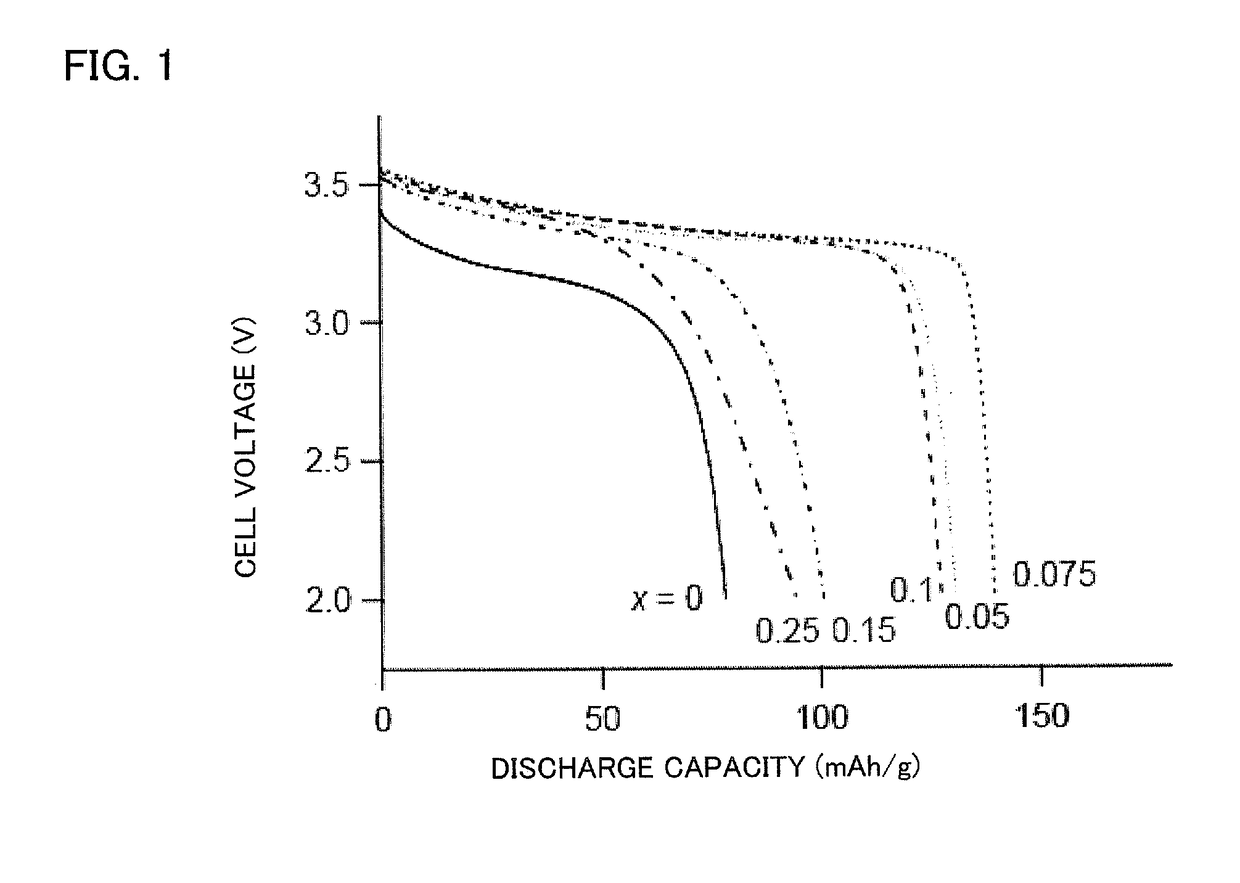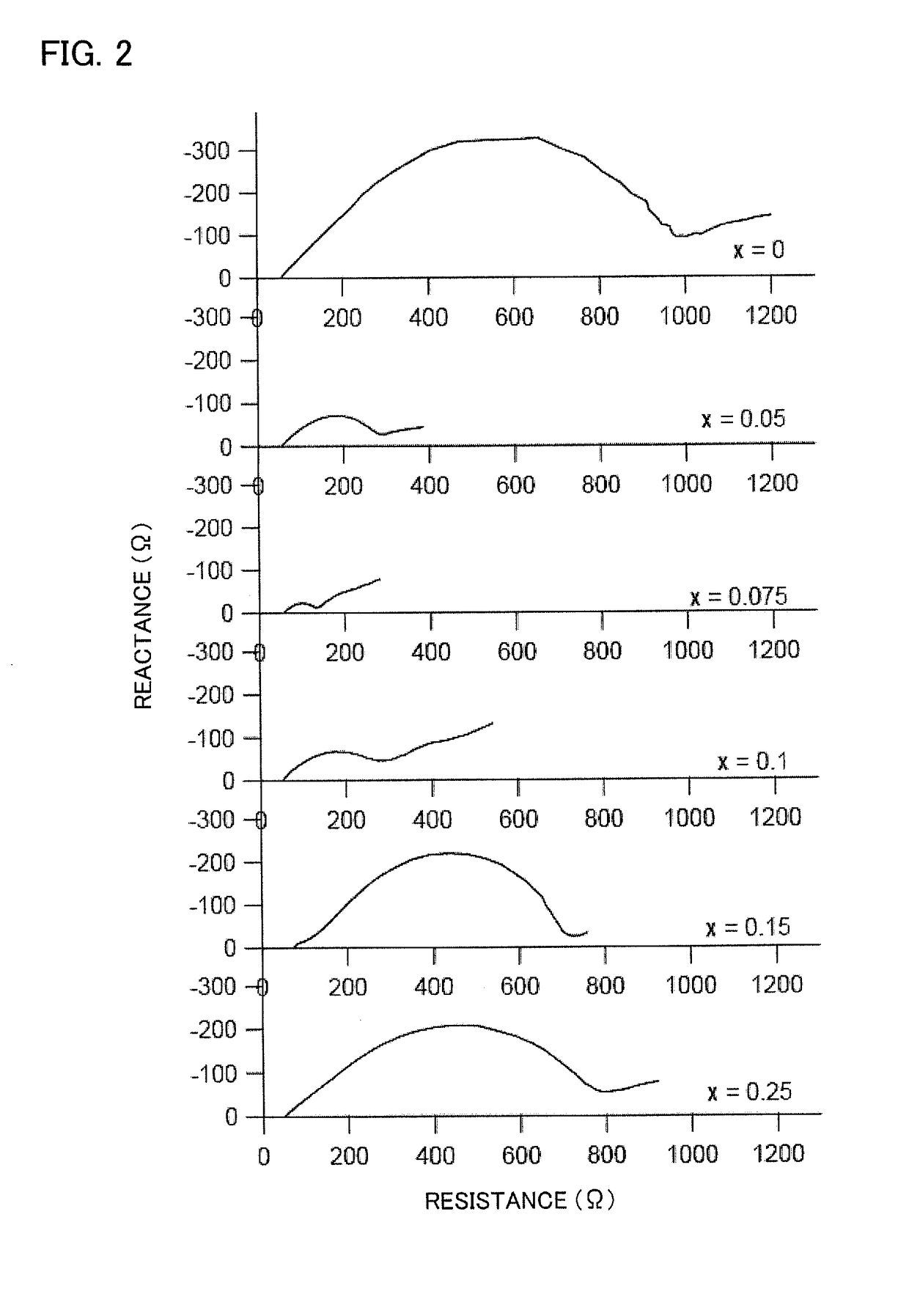All solid lithium battery
a lithium battery, all-solid technology, applied in the direction of non-aqueous electrolyte cells, cell components, electrochemical generators, etc., can solve the problems of lithium nitride having a decomposition voltage as low as 0.45 v, compound cannot be used as an electrolyte for high-voltage lithium batteries, and the titanium is susceptible to electrochemical reduction, etc., to achieve the effect of improving the electromotive force, improving the charge and discharge cycle properties
- Summary
- Abstract
- Description
- Claims
- Application Information
AI Technical Summary
Benefits of technology
Problems solved by technology
Method used
Image
Examples
examples
[0047]According to the Example of the invention, an all solid lithium battery was produced by using composite oxide of cobalt, lithium and aluminum as a composite oxide containing a transition metal that acts as a redox couple during operation of an all solid lithium battery, lithium, and at least one metal element other than those, and a solid electrolyte having composition of Li2S—GeS2—P2S5 as a solid electrolyte that contains a sulfide as a main component.
[0048]Composite oxide of cobalt, lithium, and aluminum was synthesized by a solid phase reaction method which uses lithium carbonate (Li2CO3), cobalt oxide (Co3O4), and aluminum hydroxide (Al(OH)3) as a starting material. The starting materials were admixed with one another at the molar ratio of 3:2 (1−x):6x (x=0 to 0.25) and heated at 600° C. for 10 hours to perform thermal decomposition of lithium carbonate. After that, it was heated again at 750° C. for 20 hours to synthesize composite oxide represented by LiCo1-xAlxO2. The c...
example 2
[0055]To confirm that the effect of lowering electrode resistance shown in Example 1 could lead to improved output performances, discharge behavior was examined with various discharge current densities.
[0056]The all solid lithium battery fabricated in Example 1 was charged to 3.58 V with charge and discharge current of 0.05 C followed by discharge to 2 V with discharge current of from 0.05 C to 5 C. As a result, as shown in FIG. 5, the high rate discharge performances were improved by having LiCo1-xAlxO2 in which aluminum is included, and almost no discharge capacity was observed for LiCoO2 including no aluminum at the discharge current of 5 C. On the other hand, for the sample in which x=0.075, discharge capacity of 80 mAh / g was observed even at the discharge current of 5 C.
example 3
[0057]It was shown in Example 1 that, in an all solid lithium battery using as an electrolyte a lithium ion conductive solid electrolyte which contains a sulfide as a main component, when the cathode active material was a composite oxide of cobalt that acted as a redox couple when the all solid lithium battery was under operation, lithium, and at least one metal element other than those, and the metal element was aluminum which formed an electron-insulating composite oxide with lithium, the concentration of the aluminum in a region that is in contact with the sulfide solid electrolyte was higher than the concentration inside the composite oxide and electrode resistance was lowered so that an all solid lithium battery with excellent output performances could be provided. In the present Example, to find out more clearly the relationship between aluminum concentration and output performances in a region in contact with the sulfide solid electrolyte, the correlation between performances...
PUM
| Property | Measurement | Unit |
|---|---|---|
| ion conductivity | aaaaa | aaaaa |
| decomposition voltage | aaaaa | aaaaa |
| electrochemical potential | aaaaa | aaaaa |
Abstract
Description
Claims
Application Information
 Login to View More
Login to View More - R&D
- Intellectual Property
- Life Sciences
- Materials
- Tech Scout
- Unparalleled Data Quality
- Higher Quality Content
- 60% Fewer Hallucinations
Browse by: Latest US Patents, China's latest patents, Technical Efficacy Thesaurus, Application Domain, Technology Topic, Popular Technical Reports.
© 2025 PatSnap. All rights reserved.Legal|Privacy policy|Modern Slavery Act Transparency Statement|Sitemap|About US| Contact US: help@patsnap.com



